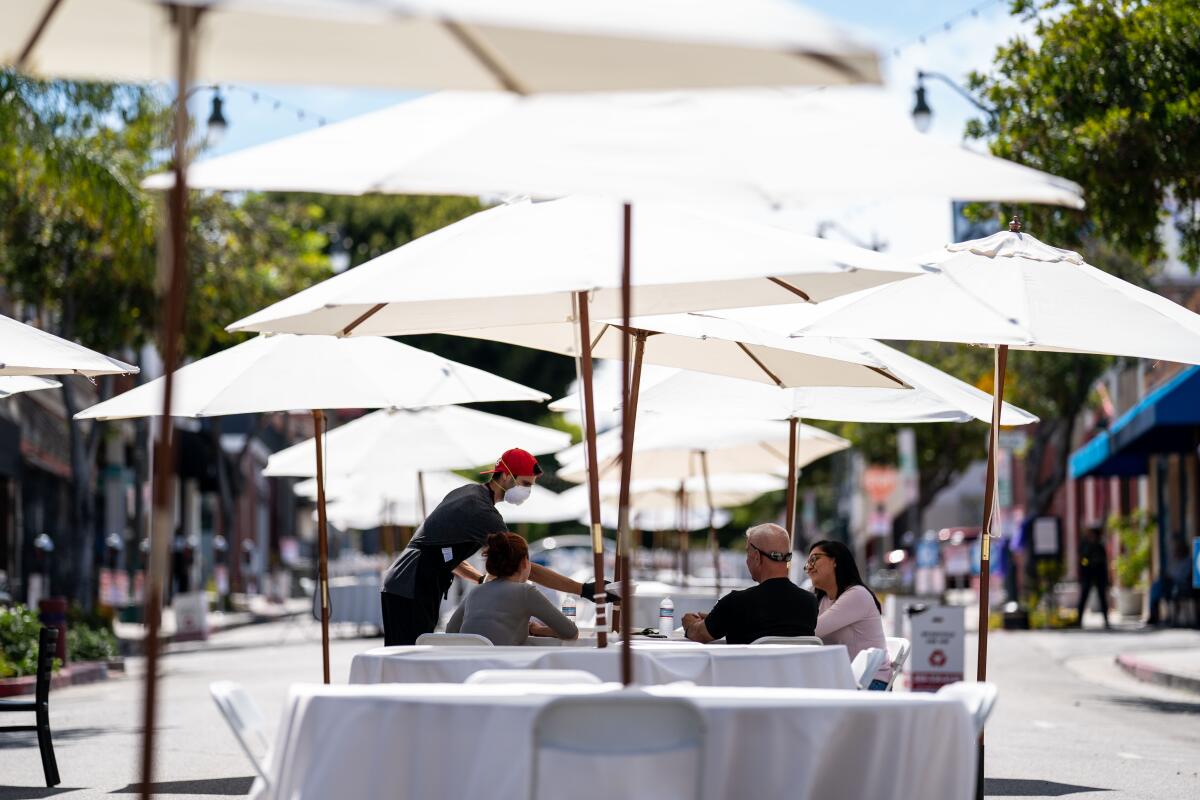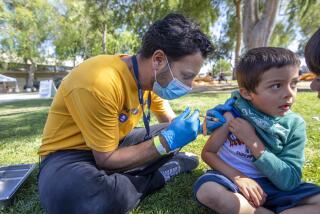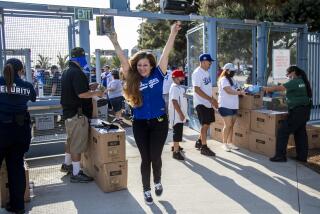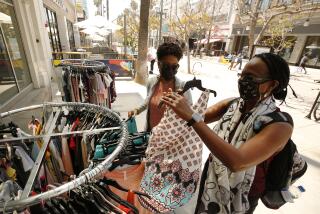L.A. is less cautious than Bay Area in coronavirus reopening. Here’s why the two regions diverged

- Share via
During the 1918 flu pandemic, Los Angeles was much more aggressive than San Francisco in combating the virus, and much slower to restart its economy.
During the current viral catastrophe, the roles are reversed.
Last week, Los Angeles announced it had received state permission to reopen hair salons, barbershops and inside dining at restaurants, even though its per capita infection rate and daily deaths were much higher than the Bay Area’s. At least one infectious-disease expert was perplexed.
“The last thing you want to do when numbers are increasing is loosen up shelter-in-place,” said Dr. John Swartzberg of UC Berkeley. “That is the bottom line. We know that sheltering in place works.”
In the current pandemic, the Bay Area shut down three days before Los Angeles, helping to quickly stem the coronavirus’ spread there, even though Silicon Valley was an early hot spot statewide. Its slower reopening has come under fire from some Bay Area businesses and residents, but its caution reveals much about the political differences between California’s two largest metropolitan areas.
In the Bay Area, public health officers have long worked closely and enjoy the support of elected leaders, making it easier to decide health strategy as a region. The Bay Area comprises multiple counties, each with its own health officer, giving them a collective strength.
Los Angeles faces different pressures. Its neighbors have fewer coronavirus cases and moved to reopen more quickly. For all but two cities, L.A. County has a single health officer, who must alone shoulder the desires and lobbying of more than 80 different cities, each with a different agenda.
When one county moves more quickly to reopen, neighboring counties are under pressure to follow.
“How do you tell somebody in Long Beach, who is suffering, that everybody living on this block can go across the street in Orange County and get their hair cut, but you as a barber can’t go back to work, when there are safe ways to do that?” L.A. Mayor Eric Garcetti asked.
San Francisco Mayor London Breed alluded to that pressure at a recent news conference, suggesting that Napa County’s reopening of restaurants had sparked questions about why San Francisco was moving more slowly. Every county is in a different situation, she said. San Francisco is the densest city in California, and the virus thrives in densely populated places.
Some have suggested that the Bay Area can more easily shelter in place because of its large tech industry, which involves tens of thousands of employees who can more easily work at home, as opposed to manufacturing and service workers.
But that theory isn’t necessarily borne out, said Chris Thornberg, an economist who heads Beacon Economics, a research and consulting firm. He said he did not believe the regions’ different economies affected varied stay-at-home orders.
Furthermore, he said, because early estimates of as many as 1 million deaths nationwide proved too high, the lockdown orders in retrospect were probably unnecessary.
“The data shows it were an overreaction,” he said. “We didn’t know this two months ago and acted with an abundance of caution, and I give them credit for that. But to me, the data screams this is unnecessary.”
Older people, who are most likely to die of COVID-19, might want to stay home, but younger people should return to work with masks and social distancing, he said.
Many health experts say that the Bay Area’s more aggressive action and a stronger and earlier stay-at-home order have played a role in limiting the spread of the highly contagious disease. Early and effective use of a shelter-in-place order is going to seem like an overreaction if it’s implemented successfully, leaving hospitals with ample capacity to care for the sick.
Dr. Tomás Aragón, health officer of the city and county of San Francisco, said the Bay Area was able to shut down early and sustain closures because health authorities enjoyed the backing of elected officials and the public.
“We really felt we had the support of the elected officials and also the population,” Aragón said during an online forum with Breed, who confessed she was frustrated with the city’s slow pace of reopening.
An early morning text. A lawyer-filled meeting on a Sunday afternoon. Emotional journal entries. And, ultimately, action.
In Santa Clara County, health officer Dr. Sara Cody recently criticized the state for reopening too quickly. At the same time, she has come under fire from some business and tech leaders for being overly cautious.
“Your public health department is operating as though nothing has been learned and nothing has changed,” said a recent full-page ad in the Mercury News, signed by former tech executive Paulette Altmaier. “Meanwhile, the economic damage from [sheltering in place] is fearsome and mounting.”
When Contra Costa County failed to reopen as quickly as some of it neighbors, residents took to the online forum Nextdoor to criticize its health officer, Dr. Chris Farnitano.
“I know there’s a lot of frustration out there,” Farnitano said in a news release Wednesday, “but it’s important to keep in mind that interventions like social distancing have saved lives.”
In Los Angeles, the drive to reopen the city and county largely came from the Board of Supervisors, but Supervisor Kathryn Barger said it was not influenced by political pressure. She noted that all of L.A. County’s neighboring counties moved ahead with an accelerated reopening schedule in the week before L.A. County went forward.
“Everything we’ve done has been based on the data brought forward by public health. And that’s been brought forward based on the criteria set by the state. And this board has been very careful to make sure that we do it in a deliberate and careful fashion based on public health,” Barger said in an interview.
Barger said the fact that the county met the state’s reopening threshold and acted a week after surrounding counties reopened shows the decision “was based on public health, not on anything else.” But the state permits counties to have stricter rules for reopening.
The most significant measure of how quickly to reopen is the number of coronavirus cases per 100,000 people, UC Berkeley’s Swartzberg said. Los Angeles County has the second-highest rate in the state, following Imperial County.
Barbara Ferrer, L.A. County director of public health, said at a recent Board of Supervisors meeting that it was “time for people to be able to get back to work.”
Still, she said, it was her job to worry about a possible surge in cases.
“We’ve always known that as more and more people are going to be out and about, we run this risk of there being a surge,” Ferrer said. “It’d be one thing to see a slight increase, which we would anticipate from having more people out and about. What we have to avoid is that huge increase that causes a threat to our healthcare system.”
L.A. County received state approval in part by meeting two benchmarks: stable or decreasing hospitalization rates of COVID-19 patients and a rate of no more than 8% of residents testing positive for the virus. From May 18 to May 24, L.A. County reported that of people who underwent tests, 6.7% tested positive. During that same time period, the number of patients in hospitals with confirmed diagnosis of the coronavirus declined by 1%.
In defending San Francisco’s go-slow approach, Aragón noted that Lassen and Sonoma counties saw a surge of cases after taking steps to reopen. Lassen had to pull back, he said.
During the 1918 flu pandemic, Aragón said, the places that reopened slowly did better economically because they did not have large second waves of infection.
Bay Area health officers believe the reopening must be done in phases, starting with resuming the lowest-risk activities. It takes two to four weeks to observe the effect of each reopening on new infections and hospitalizations, Aragón said.
Both Contra Costa and Santa Clara counties have recently announced looser restrictions, including permitting indoor retail shopping, although much remains closed because of concerns over protests and sporadic theft and property damage triggered by the police killing of George Floyd in Minneapolis.
“These are not easy decisions to make,” said Garcetti in Los Angeles. “And I’ve always said: We would not do things one day earlier than we needed to, or one day later than we needed to. But it is very clear. We have larger-than-Great-Depression unemployment in Los Angeles.”
Times staff writers Joseph Serna and Colleen Shalby contributed this report.
More to Read
Sign up for Essential California
The most important California stories and recommendations in your inbox every morning.
You may occasionally receive promotional content from the Los Angeles Times.















